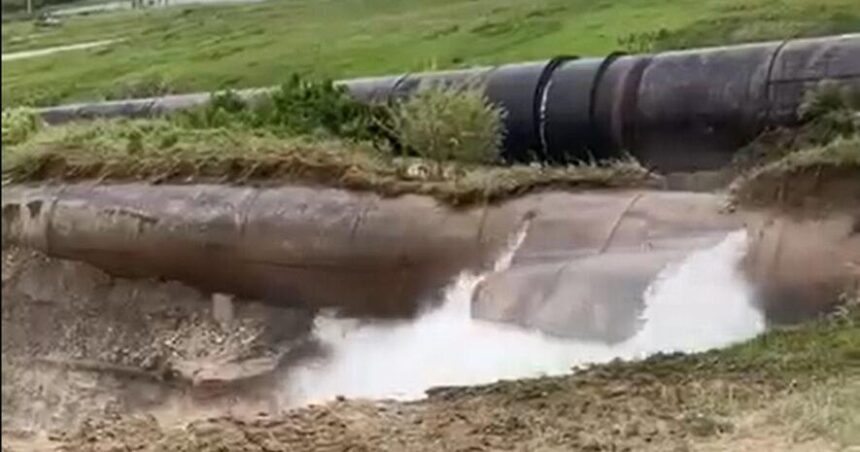“Catastrophic” failures of the St. Mary Canal Siphon led to damage in the Babb area Monday morning.
In a press release, the Bureau of Reclamation said the St. Mary Canal Siphon breached around 8:45 a.m. and resulted in isolated flooding and erosion. Some washout areas were between 30-50 feet deep. Later in the day, the Milk River Project said in a Facebook post that at around 1:50 p.m., the siphon additionally had a “catastrophic failure at the inlet of both siphon tubes.”
“The powerful water flow caused the 100+ year-old siphons to break apart, washing away the concrete structures holding the pipes underneath,” the post said.
At the time of initial failure, the diversions into the canal were 600 cubic feet per second, according to Reclamation, and they have since been stopped. Flows are still expected to continue, however, up to 36 hours while the canal drains, the release said.
People are also reading…
Emergency response teams responded, as well as local law enforcement. Reclamation is also working with the Gallatin County Sheriff’s Department, Blackfeet Tribe, National Park Service, Glacier County Sheriff’s Department, and Glacier Electric.
“Emergency response teams have been deployed to contain and evaluate the damage,” said Ryan Newman, Reclamation’s Montana Area office manager, in the release. “Water flows were naturally diverted back to the St. Mary River and helped mitigate the potential for additional flooding in the surrounding area.”
Roads are closed in the area. No one was hurt, a Facebook post from the Milk River Project said, but “the damage is extensive.” That included the hillside and Hook’s Hide-Away bar, motel and roping arena.
Reclamation is working to assess the damage and cause of the failure. According to the Milk River Project, the siphon failed as “Reclamation personnel were monitoring a crack.” Reclamation said in the press release “we will be evaluating both short term solutions, if any, along with long-term rebuild options. Detailed inspections will commence as soon as the water empties from the line and surrounding ground is determined to be stable.”
The Blackfeet Tribe on Monday ordered the St. Mary Canal and Milk River in Babb closed to all river activities, including floating, boating, rafting, swimming and anything else through June 24. The Tribe told people to stay out of the area. Road closures are also in effect near the area.
In a press release, eastern congressional district U.S. Rep. Matt Rosendale said there will be a Joint Board of Control meeting in Malta at 6 p.m. Tuesday (June 18) to provide updates after Reclamation engineers evaluate the failure.
“Thankfully no Montanans were injured in this catastrophe earlier today,” Rosendale said in a press release, going on to criticize the Biden Administration.
Sen. Jon Tester in a press release said he wanted immediate action from the Department of Interior and the Department of Agriculture to “ensure that the local community and the irrigators have the resources they need to confront the challenges that lay ahead.”
“The timing of this failure could not be worse because hundreds of farmers and ranchers are currently depending on the Milk River Project to irrigate their crops,” Tester wrote in a letter to Secretary of the Interior Deb Haaland and Secretary of Agriculture Tom Vilsack.
In a post on X, Sen. Steve Daines said “I’m monitoring the concerning siphon breach on the St. Mary Canal and have been in contact with local irrigators as well as the Bureau of Reclamation. The damage is serious, and I’m standing by to help local authorities in any way necessary.”
He issued a second statement after the later failure, telling people to “stay vigilant and stay away from the affected areas.”
Gov. Greg Gianforte said in a post on X that “I am actively monitoring the siphon breach on the St. Mary Canal. The state is working with local and federal authorities to identify the extent of damage caused to the surrounding area and to water users.” He also urged caution after the second failure.
Recently a Bozeman company was awarded $88 million to repair the St. Mary Diversion Dam and Canal. A project manager said the dam is “severely dilapidated,” according to reporting by The Billings Gazette. The contact came from $100 million for the Milk River Project that’s part of the bipartisan Infrastructure Investment and Jobs Act.
Construction on the St. Mary storage unit started in 1906, according to the Bureau of Reclamation, with St. Mary Diversion Dam completed in 1915. It serves 120,000 acres of irrigated and and about 14,000 municipal users.





